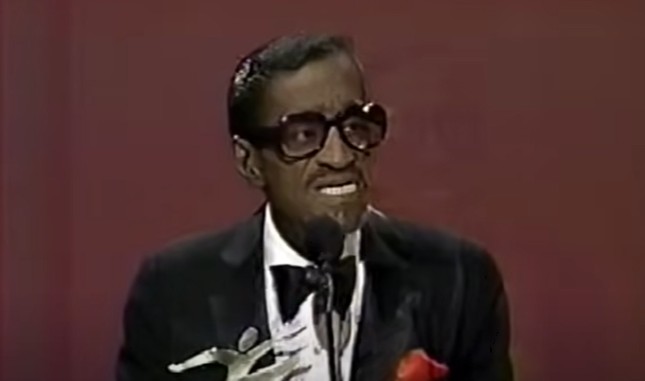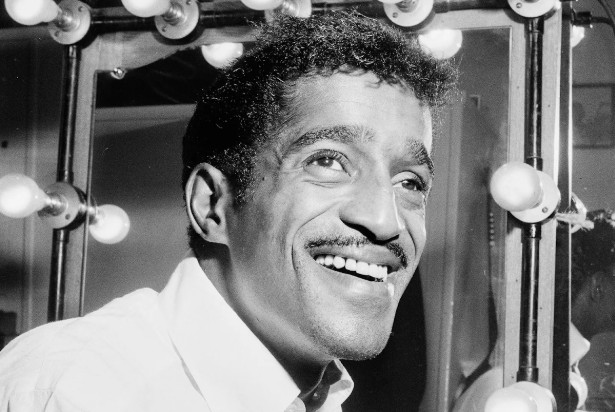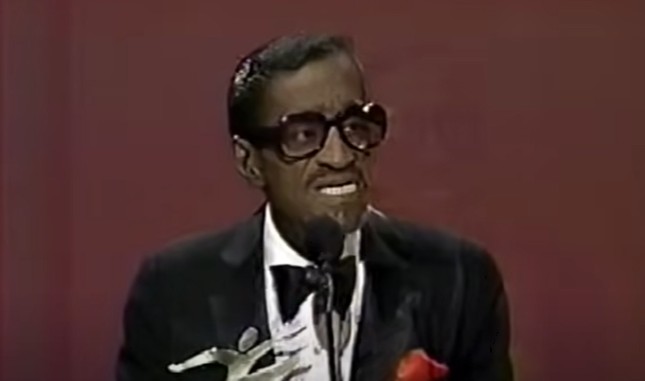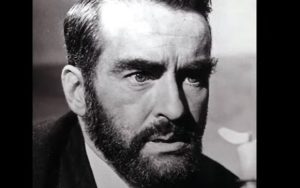I still remember the first time I saw it—his last photo. Sammy Davis Jr., frail but dapper, eyes sunken but still twinkling with that familiar mischief, was seated beside his wife, Altovise. There was something quietly heroic about it. The image didn’t scream celebrity or glamour—it whispered endurance. And it made me pause.
You see, we often think of our idols as immortal, caught in a loop of greatest hits and grainy concert footage. But that one final image? It reminded me that legends, too, grow tired. They fade. But oh, how brightly they once burned.
Sammy Davis Jr. Last Photo: A Farewell Glimpse

Image Credit: YouTube
There’s a stillness in Sammy Davis Jr.’s last photo that speaks louder than any of his show-stopping performances. It’s not the glitzy Sammy we grew up watching—the one doing backflips in a tux or cracking jokes on late-night TV. No, this was a quiet Sammy. Tired, fragile, yet somehow more real than ever.
The photo captures him sitting calmly in a tailored suit, a soft hat pulled low, his eyes shaded but alert. You can see the weight of a lifetime in his posture—decades of racial battles, applause, heartbreak, reinvention. And beside him, Altovise is gently leaning in, as if holding him steady with her presence alone.
When I look at that image, it doesn’t feel staged. It feels sacred. Like a final bow without the curtain call. It’s not the Sammy of the spotlight, but the man behind it—the one who gave everything and somehow still smiled through the weariness.
It’s a farewell glimpse, yes—but not of defeat. It’s a snapshot of grace, dignity, and a life beautifully worn.
What Was Happening in Sammy Davis Jr.’s Life Before the End?
By the late 1980s, Sammy Davis Jr.—once a dancing, crooning, joke-cracking dynamo—was slowing down. Decades of performing in smoky lounges, headlining Vegas stages, and being “on” for everyone had taken its toll. And let’s not forget, this man had lived several lives in one.
He had already battled and beat liver cancer in the early ‘80s. But then, in 1989, the diagnosis returned. This time, it was throat cancer. For a man whose entire being was wrapped in voice and rhythm, it was a cruel irony. He reportedly continued to perform well into the early stages of treatment. That’s the thing about Sammy—he didn’t just live to perform, he needed it.
But behind the curtain, friends said he was in pain. He had lost his voice. His signature swagger had softened. Still, he kept showing up—at galas, at charity events, even when the cameras weren’t rolling. Always suited. Always smiling. Always Sammy.
How Did Sammy Davis Jr. Change the Entertainment World?
To say Sammy Davis Jr. changed the game would be underselling it. He was the game. A triple threat—singer, dancer, actor—at a time when being Black and famous meant fighting twice as hard for half the recognition.
You might remember that infamous moment when he kissed Archie Bunker on All in the Family. It was 1972, and America was in knots over race, identity, and change. Sammy walked onto that set and made people laugh, then made them think. He had a knack for that.
But more than his media moments, Sammy broke real ground. He was the first Black performer to sleep in a Vegas hotel he headlined. The first to force clubs to drop segregation policies if they wanted his name on the marquee. He didn’t just open doors—he knocked them off the hinges and danced through the rubble.
Why Did His Last Years Feel So Bittersweet?
Because legends deserve standing ovations, not slow fade-outs. And Sammy’s final years were filled with both admiration and quiet sorrow.
Financial troubles plagued him—imagine owing the IRS millions after entertaining the world for half a century. His health declined rapidly. Some friends fell away. Others, like Frank Sinatra, stuck around. In fact, it was Sinatra who paid for Sammy’s medical bills when things got tough.

Image Credit- Vanity
You’d think the world would have showered him with gratitude. Instead, his last years often felt like a fight to remind people who he had been. It’s a sobering truth in Hollywood: once you stop shining, the spotlight doesn’t always wait.
Still, Sammy kept showing up. That’s what makes his last photo so powerful. It’s not filtered or staged. It’s simply Sammy—weathered, human, and deeply loved.
What Is the Legacy of Sammy Davis Jr. Today?
When I hear his voice now—crooning “Mr. Bojangles” or snapping his fingers mid-jazz—I get chills. Not because of the perfection, but because of the emotion. Sammy Davis Jr. didn’t just sing songs. He lived them.
Today, artists like Bruno Mars, Jamie Foxx, and Donald Glover are standing on Sammy’s shoulders. His influence is everywhere—from multihyphenate stardom to defiant joy in the face of injustice.
And for all the razzle-dazzle, maybe his greatest legacy is empathy. He spent his life connecting people who thought they had nothing in common. Jews and Catholics. Black and white. Liberals and conservatives. He blurred the lines, even when it cost him dearly.
In a world still struggling with difference, that legacy feels more relevant than ever.
One Final Look Back at a Timeless Soul
Image Credit- Vanity
There’s something haunting about a last photo. It’s not just the end—it’s a mirror held up to a life well lived. Sammy’s last image doesn’t feel like goodbye. It feels like gratitude. Like someone saying, “I gave it everything.”
So here’s my gentle nudge to you: go play his rendition of “The Candy Man.” Watch him tap dance beside Gregory Hines. Revisit that clip where he joins Martin Luther King Jr. on stage. You won’t just see a performer. You’ll see a warrior in patent leather shoes.
Because Sammy Davis Jr. wasn’t just a star—he was a constellation. And even now, his light’s still bouncing back at us.
FAQ: Remembering Sammy Davis Jr.
1. What was Sammy Davis Jr.’s cause of death?
Sammy Davis Jr. passed away on May 16, 1990, due to complications from throat cancer. He was 64. The disease had taken his voice, but never his spirit.
2. Who was with Sammy in his final days?
His wife, Altovise Davis, was by his side throughout. Close friends like Frank Sinatra and Dean Martin also visited and supported him toward the end. He died at his Beverly Hills home surrounded by family.
3. Why is Sammy Davis Jr. considered a trailblazer?
Sammy broke racial barriers in the entertainment industry. He was one of the first Black performers to headline major venues, demand integrated audiences, and use his fame to fight for civil rights. He also openly converted to Judaism, challenging public expectations and prejudices.
4. Where can I see his final public photo?
While not widely circulated in tabloids, the last known photo of Sammy Davis Jr. occasionally surfaces in tribute documentaries and retrospectives. It’s a simple image, but one that carries incredible emotional weight.
5. Who paid for Sammy Davis Jr.’s funeral?
Frank Sinatra covered the funeral expenses for his close friend, Sammy Davis Jr. Additional sources also mention that other Rat Pack members—like Dean Martin and Joey Bishop—helped contribute to the cost.
6. Did Frank Sinatra attend Sammy Davis Jr.’s funeral?
Yes—Frank Sinatra not only attended, but he also canceled tour dates to be there. He served as an honorary pallbearer and sat front‑row alongside other members of the Rat Pack.
7. Who attended Sammy Davis Jr.’s funeral?
Sammy’s funeral was a star-studded event held at Forest Lawn Memorial Park:
-
Frank Sinatra (honorary pallbearer)
-
Dean Martin (Rat Pack member)
-
Liza Minnelli
-
Stevie Wonder
-
Robert Guillaume
-
Gregory Hines
-
Berry Gordy, Milton Berle, Valerie Harper, Robert Wagner, and Johnny Brown, among many others.
Additionally, around 2,500 mourners attended the memorial, and traffic backed up for miles—one of the largest celebrity funeral processions recorded.



